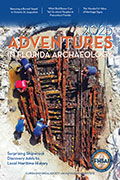The traditional culture of the Seminole Tribe of Florida is preserved at the Ah-Tah-Thi-Ki Museum on the Big Cypress Reservation in south Florida, near Clewiston.
The state of the art museum and archival facility features permanent exhibitions and rotating gallery space, a research library, and an extensive collection of newspapers, oral histories, manuscripts, and artifacts including patchwork clothing, baskets, and dolls.
In the Seminole language Ah-Tah-Thi-Ki means “a place to learn” or “a place to remember.”
“That’s really what we hope to do here at the museum, is to educate the public but also to keep the traditions and culture alive within our own tribe,” says traditional arts coordinator Pedro Zepeda.
“We want this to be the source for tribal history and culture for people,” says director Anne McCudden. “We want this to be the place where people can come to get the correct information, to meet tribal members, and to really experience tribal culture one-on-one.”
In the 1700s, Lower Creek Indians from Georgia and Alabama migrated into Florida, blending with remnants from some of Florida’s indigenous tribes and runaway slaves. By the 1770s, this group of people became known as Seminole, which means “wild people” or “runaway.”
Throughout the 1800s, a series of three Seminole Wars took place, as the United States government sought to expand its territory, and recapture runaway slaves. By 1858, about 300 Seminole remained in the swamps of south Florida.
In the twentieth century, the Seminole capitalized on the state’s growing tourism, and remained active in citrus growing and the cattle industry. Today, the Seminole have expanded into the hotel, restaurant and gaming businesses as owners of the worldwide Hard Rock franchise.
“The policy of the United States was to eradicate us in the 1800s, and we’ve survived,” says outreach specialist Willie Johns. “This museum houses all the pictures and all the stories of all these people that did survive. They made a living out of nothing in this Florida wilderness. They made the Seminole Tribe what it is today.”
Johns travels all over the state using artifacts from the Ah-Tah-Thi-Ki Museum to introduce people to Seminole culture.
Throughout the Ah-Tah-Thi-Ki Museum, life sized figures are used to demonstrate traditional Seminole clothing and practices such as hunting, fishing, canoeing, and performing the Green Corn Dance. Wood carvings, jewelry, and baskets are also displayed.
“I really like the palmetto baskets that we have on display,” says Pedro Zepeda. “That’s something that my family used to make from saw palmetto stems. Seminole arts are usually associated with the sweet grass baskets, but that’s something that we didn’t develop until the tourist trade after the turn of the (twentieth) century. These palmetto baskets were our work baskets and our ceremonial baskets. Those are the ones that we used in our day to day lives.”
“We also have Osceola’s bandolier bag,” says curator of exhibits Saul Drake. “That’s incredibly powerful for Seminole tribal members to be able to see that and connect that to a very strong portion of history in the Seminole Tribe. That’s kind of a symbol of how far the Seminole Tribe has come.”
One of the rotating exhibitions at the museum is called “Postcards and Perceptions: Culture as Tourism.” It shows how the Seminole fueled Florida tourism in the early twentieth century.
“These postcards that were mass produced are representations of actual real people that lived during this time period. We have tribal members that come into the museum and say ‘oh, that’s my grandmother’ or ‘that’s my great uncle’ and it’s such a strong connection,” says Drake.
As with most museums, only a small portion of the Ah-Tah-Thi-Ki collection can be displayed at one time. The museum has a high-tech preservation and storage facility, and shares items with the Smithsonian Institution, the Museum of Florida History, and other organizations.
More than a mile of boardwalk leads from the museum to an Indian village and ceremonial center. Visitors can experience the natural Florida while learning about how the Seminole interact with the environment.
“Ethnobotanical signage gives you background on the plant itself, and some cultural information on how the Seminole used them in the past,” says Drake.
The Ah-Tah-Thi-Ki Museum lives up to its name.









